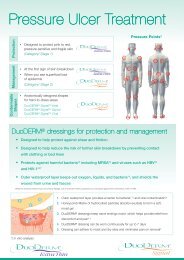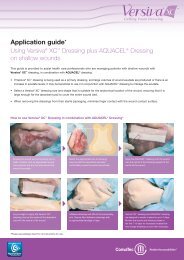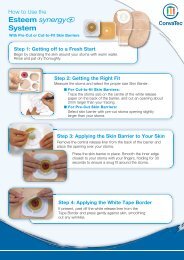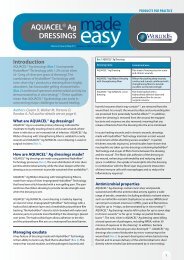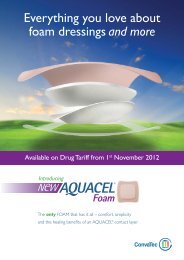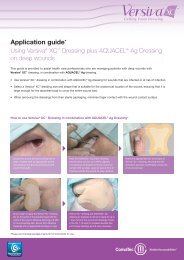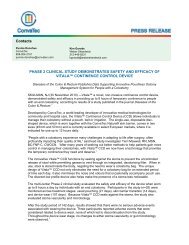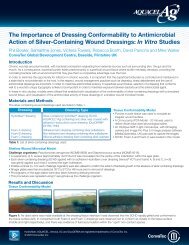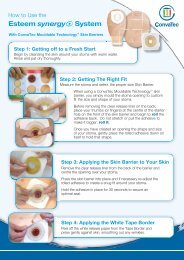Wound Product Reference Guide - ConvaTec
Wound Product Reference Guide - ConvaTec
Wound Product Reference Guide - ConvaTec
You also want an ePaper? Increase the reach of your titles
YUMPU automatically turns print PDFs into web optimized ePapers that Google loves.
Section 2<br />
Indication<br />
AQUACEL dressing is indicated as a primary dressing for moderate<br />
to highly exuding wounds.<br />
• Chronic wounds: leg ulcers, pressure sores, diabetic ulcers<br />
• Acute wounds: donor sites, abrasions, lacerations, post-surgical<br />
wounds and first- and second-degree burns<br />
AQUACEL dressing can be used on infected wounds under medical<br />
supervision in an appropriate protocol of care and for wounds that<br />
require autolytic debridement.<br />
Application<br />
Carefully cleanse the wound with saline (e.g., Irriclens cleanser), and dry<br />
the surrounding skin before placing AQUACEL dressing directly onto the<br />
wound allowing an overlap onto the surrounding skin of at least 1cm.<br />
For cavity wounds, loosely pack AQUACEL dressing ribbon to about 80%<br />
capacity leaving at least 2.5cm outside the wound for easy retrieval.<br />
The AQUACEL dressing should then be covered with an appropriate<br />
moisture retentive secondary dressing such as, but not limited to, Versiva<br />
XC dressing, Granuflex dressing, Granuflex Bordered dressing, DuoDERM<br />
Extra Thin dressing, or DuoDERM Signal dressing. Please refer to pack<br />
insert for full instructions prior to use.<br />
CLINICAL BENEFITS<br />
• Supports moist wound-healing environment<br />
• Promotes faster wound-healing 10<br />
• Highly absorbent, giving longer wear time than alginate 5 or gauze 4<br />
• Retains fluid within its structure, reducing the risk of maceration and excoriation 7<br />
• Soft and conformable, adding to patient comfort<br />
• Cohesive gel allows easy, atraumatic removal<br />
• Costs less overall than gauze 8,9 and an alginate 6 by saving time, money<br />
and resources<br />
8 Harding KG, Price P, Robinson B, Thomas S, Hofman D. Cost<br />
and dressing evaluation of Hydrofiber and alginate dressings in<br />
the management of community-based patients with chronic leg<br />
ulceration. <strong>Wound</strong>s. 2001;13:229-236.<br />
9 Guest F Julian, Ruiz J Francis. Modelling the cost implications of<br />
using Carboxymethylcellulose dressing compared with gauze in<br />
the management of surgical wounds healing by secondary<br />
intention in the US and UK Current Medical Research and<br />
Opinion. 2005;21(2):281-290.<br />
10 Piggesi A, Baccetti F, Rizzo L, Romanelli* M, Navalesi R, Benzi L.<br />
Sodium carboxyl-methyl-cellulose dressings in the management<br />
of deep ulcerations of diabetic foot. Diabetic Medicine.<br />
2001;18(4):320-324.<br />
11 AQUACEL and AQUACEL Ag with Strengthening Fiber.<br />
WHRI3178TA155. October 31, 2008. Data on file. <strong>ConvaTec</strong>.<br />
7





